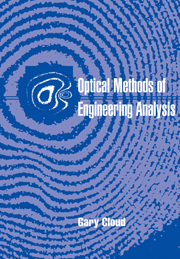Book contents
- Frontmatter
- Contents
- Acknowledgments
- 1 Introduction and orientation
- Part I Optics and interferometry
- Part II Photoelasticity
- Part III Geometrical moire
- Part IV Diffraction theory, optical processing, and moire
- 10 Diffraction and Fourier optics
- 11 Moire with diffraction and Fourier optical processing
- 12 Procedures of moire analysis with optical processing
- Part V Moire interferometry
- Part VI Holographic interferometry
- Part VII Speckle methods
- Author index
- Subject index
11 - Moire with diffraction and Fourier optical processing
Published online by Cambridge University Press: 12 January 2010
- Frontmatter
- Contents
- Acknowledgments
- 1 Introduction and orientation
- Part I Optics and interferometry
- Part II Photoelasticity
- Part III Geometrical moire
- Part IV Diffraction theory, optical processing, and moire
- 10 Diffraction and Fourier optics
- 11 Moire with diffraction and Fourier optical processing
- 12 Procedures of moire analysis with optical processing
- Part V Moire interferometry
- Part VI Holographic interferometry
- Part VII Speckle methods
- Author index
- Subject index
Summary
In this chapter, diffraction and spatial filtering theory are put to good use in moire measurement of displacements, with significant gains in sensitivity and flexibility. Before we describe the method, some additional development of diffraction by superimposed gratings is necessary. Improvement of moire results by performing spatial filtering during the grating photography is also explored.
The basic idea
Although useful moire fringe patterns can be obtained by direct superposition of the grating photographs with one another or with a submaster grating, as is discussed in Chapter 8, such a simple procedure does not yield the best results, nor does it exploit the full potential of the information that is stored in a photograph of a deformed specimen grating. Increased sensitivity, improved fringe visibility, and control of the measurement process can be had by utilizing some of the basic procedures of optical data processing.
Three related physical phenomena are important in developing an understanding of moire fringe formation and multiplication by superimposing grating photographs in a coherent optical analyzer. The first of these phenomena is the diffraction of light by a grating, or more accurately, by superimposed pairs of gratings having slightly different spatial frequencies. The second is the interference fringe patterns that are produced in the diffraction orders by interference of two beams that come together at small relative inclination. The third important phenomenon is that a simple lens acts as a Fourier transformer or spectrum analyzer and offers the possibility of performing filtering operations on space-dependent optical signals in a manner analogous to the treatment of time-dependent vibration and electrical signals. Actually, these concepts are not independent from each other; they are manifestations of fundamental interference and diffraction processes.
- Type
- Chapter
- Information
- Optical Methods of Engineering Analysis , pp. 226 - 240Publisher: Cambridge University PressPrint publication year: 1995

